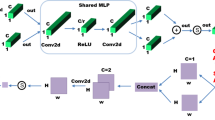Abstract
With the development of remote sensing technology, satellite images with the characteristics of multi-scale, multi-band, and multi-date make it tend to be big data. So how to raise the extraction speed, precision and automatic degree of salient objects from high-resolution remote sensing images become urgent problems. Based on the analysis using an Itti visual attention model for natural image processing, we achieved improvements in two aspects: (1) the selection of salient regions based on elevation data, and (2) the segmentation of salient regions using the Snake model for precise object contour extraction. Tests on the extraction of 2.5 m high-resolution remote sensing image data in the rare earth mining area in Dingnan County, Jiangxi Province showed a false alarm rate of 14.8 % and a missing alarm rate of 8.4 % in the extraction of mine quantity data. The proposed method could be useful for improving the speed, precision and automatic extraction of salient objects from high-resolution remote sensing images as well as the boundary information of salient objects that are based on a visual attention model.






Similar content being viewed by others
References
Wang, L., Lu, K., Liu, P., Ranjan, R., Chen, L.: IK-SVD: dictionary learning for spatial big data via incremental atom update. Comput. Sci. Eng. 16(4), 41–52 (2014)
Miao, Y., Wang, L., Liu, D., Ma, Y., Zhang, W., Chen, L.: A web 2.0-based science gateway for massive remote sensing image processing. Concurr. Comput.: Pract. Exp. (2013). doi:10.1002/cpe.3049
Ma, Y., Wang, L., Zomaya, A.Y., Chen, D., Ranjan, R.: Tasktree based large-scale mosaicking for massive remote sensed imageries with dynamic dag scheduling. IEEE Trans. Parallel Distrib. Syst. 25(8), 2126–2137 (2014)
Zhang, W., Wang, L., Ma, Y., Liu, D.: Design and implementation of task scheduling strategies for massive remote sensing data processing across multiple data centers. Softw. Pract. Exp. 44(7), 873–886 (2014)
Guo, H., Wang, L., Chen, F., Liang, D.: Scientific big data and digital earth. Chin. Sci. Bull. 59(35), 5066–5073 (2014)
Treisman, A.M., Gelade, G.: A feature-integration theory of attention. Cogn. Psychol. 12(1), 97–136 (1980)
Koch, C., Ullman, S.: Shifts in selective visual attention: towards the underlying neural circuitry. Hum. Eurobiol. 4, 219–227 (1985)
Oliva A., Torralba M., Castelhano S., et al.: Top-down control of visual attention in object detection. In: IEEE International Conference on Image Processing, pp. 253–256. (2003)
Zhang, Q.R., Xiao, H.M.: A hierarchical computational model of visual attention using multi-layer analysis. In: International Conference on Communication Systems, Networks and Applications, pp. 267–270. (2010)
Walther, D.B., Koch, C.: Attention in hierarchical models of object recognition. Prog. Brain Res. 165, 57–78 (2007)
Feynman, R.P., Hibbs, A.R.: Quantum Mechanics and Path Integrals, p. l-365. McGraw-Hill, New York (1965)
Itti, L., Koch, C., Niebur, E.: A model of saliency-based visual attention for rapid scene analysis. IEEE Trans. PAMI 20(11), 1254–1259 (1998)
Navalpakkam, V., Itti, L.: Modeling the influence of task on attention. Vis. Res. 45(2), 205–231 (2005)
Sun, Y., Fisher, R.: Object-based visual attention for computer vision. Artif. Intell. 146(1), 77–123 (2003)
Hou, X. and Zhang, L.: Saliency detection: a spectral residual approach. In: Computer Vision and Pattern Recognition, pp. 1–8. (2007)
Frintrop, S.: VOCUS: a visual attention system for object detection and goal-directed search. Springer, Heidelberg (2006)
Rybak, I.A., Gusakova, V.I., Golovan, A.V., et al.: A model of attention-guided visual perception and recognition. Visual Res. 38, 2387–2400 (1998)
Chernyak, D.A., Strark, L.W.: Top-down guided eye movements. IEEE Trans. Syst. Man Cybern. 31(4), 514–522 (2001)
Burt, P.J., Adelson, E.H.: The Laplacian pyramid as a compact image code. Communications 31(4), 532–540 (1983)
Cohen, L.D. and Cohen, I.: A finite-element method applied to new activecontour models and 3-D reconstruction from cross sections. In: Proceedings of Third International Conference on Computer Vision, pp. 587–591. Osaka, JaPan.Dee (1990)
Acknowledgments
This work was supported by the grant from the National Natural Science Foundation of China (60972142), the ten-year investigation special ecological environment (STSN-10-03), the National High Technology Research and Development Program of China (2012BAH27B05), 135 Strategy Planning of Institute of Remote Sensing and Digital Earth, CAS.
Author information
Authors and Affiliations
Corresponding author
Rights and permissions
About this article
Cite this article
Song, X., He, G., Zhang, Z. et al. Visual attention model based mining area recognition on massive high-resolution remote sensing images. Cluster Comput 18, 541–548 (2015). https://doi.org/10.1007/s10586-015-0438-8
Received:
Revised:
Accepted:
Published:
Issue Date:
DOI: https://doi.org/10.1007/s10586-015-0438-8




